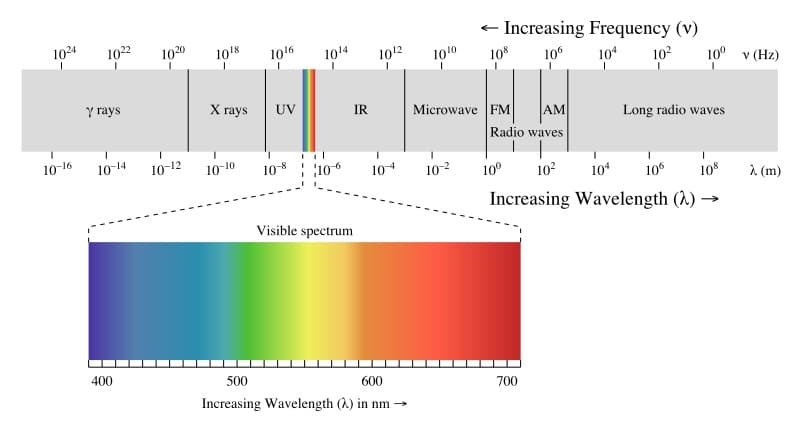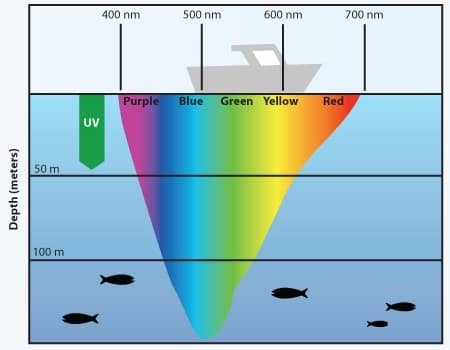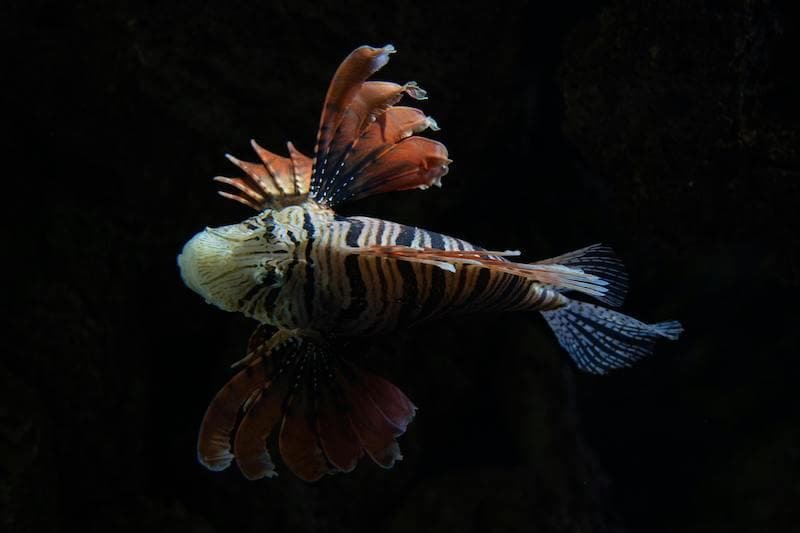
 Roni Essex
Freediver, Spearo, Creator
Roni Essex
Freediver, Spearo, Creator

 Roni Essex
Freediver, Spearo, Creator
Roni Essex
Freediver, Spearo, Creator
As we descend into the depths, the colors we encounter undergo a fascinating transformation due to the selective absorption of light by water molecules and other substances present in the ocean. In this blog post, we'll explore the science behind the absorption of colors deep at sea, examining specific examples and delving into relevant data to shed light on this captivating phenomenon.
Understanding the absorption spectrum is fundamental to grasping the intricacies of how light interacts with water and various substances within it. The absorption spectrum is a graphical representation of the amount of light absorbed by a substance at different wavelengths. In the context of underwater environments, it provides a valuable tool for unraveling the mysteries of color transformation as sunlight permeates the ocean depths.
At its core, the absorption spectrum is a reflection of how different wavelengths of light are absorbed or transmitted by a medium. Each color in the visible spectrum corresponds to a specific wavelength, with red having longer wavelengths than blue. As sunlight enters the water, this spectrum undergoes a transformation dictated by the unique optical properties of H2O molecules and dissolved particles.
Water, by nature, is not a completely transparent medium. It selectively absorbs certain wavelengths of light while allowing others to penetrate to varying degrees. The selective absorption is influenced by the molecular composition of water, particularly the presence of chlorophyll, dissolved organic matter, and other substances. This selectivity is the primary driver behind the changes in color observed as one descends into the ocean.
The absorption spectrum is heavily influenced by the electronic structure of water molecules. Vibrational and rotational transitions within these molecules absorb energy at specific wavelengths, contributing to the overall absorption pattern. The energy associated with these transitions is often sufficient to cause changes in the molecular structure of water, leading to temperature variations within different layers of the ocean.
As sunlight penetrates the ocean's surface, its intensity diminishes, and specific colors succumb to absorption at different rates. Red, being on the longer wavelength end of the spectrum, is the first to be absorbed, creating a gradient of colors as one descends. The interplay of absorption and scattering determines the dominance of certain colors at various depths, resulting in the mesmerizing hues that characterize the underwater world.
The absorption spectrum has practical implications for a range of scientific disciplines. Oceanographers and marine biologists leverage this knowledge to study the distribution of marine life, the health of ecosystems, and the impact of environmental factors on underwater light conditions. Engineers designing underwater sensors and imaging systems take into account the absorption characteristics of water to develop instruments capable of accurate data collection in different depths and conditions.
Beyond water molecules, the absorption spectrum is influenced by suspended particles, dissolved minerals, and organic matter present in the water. These substances contribute to the complexity of the spectrum, creating distinct absorption peaks and valleys at specific wavelengths. The variability in these substances across different regions of the ocean further adds to the diversity of underwater coloration.
Advances in technology, such as the development of hyperspectral imaging and sophisticated spectroscopy techniques, have allowed scientists to delve deeper into the intricacies of the absorption spectrum. These tools enable researchers to analyze the spectrum with high precision, uncovering subtle nuances in color absorption and providing a more nuanced understanding of underwater light dynamics.
The absorption spectrum plays a role in global climate dynamics. Changes in the Earth's climate can influence the distribution of substances in the ocean, altering the absorption spectrum and, consequently, the heat absorption and distribution in the ocean. This interconnected web of factors highlights the importance of understanding the absorption spectrum in a broader environmental context.

Image by Exploring Our Fluid Earth
At the surface, where the ocean meets the sunlight, red emerges in its full glory. Objects like vibrant corals, flamboyant fish, and intricate sea anemones proudly display their crimson shades. Yet, as the descent into the ocean begins, the fate of red is sealed by the selective absorption properties of water.
The absorption spectrum of water acts as a spectral gatekeeper, determining which wavelengths of light will continue their journey into the depths and which will succumb to absorption. Red light, residing at the longer end of the spectrum, encounters a hurdle it cannot easily overcome. Water molecules, particularly those associated with the vastness of the ocean, absorb red light with a voracious appetite, effectively quenching its brilliance.
As we delve deeper into the ocean, the absorption of red becomes increasingly pronounced. Data from underwater measurements reveals that at just 10 meters, a substantial portion of red light, approximately 50%, has already been absorbed. This depth-dependent absorption escalates rapidly, with nearly 95% absorption at 20 meters, and close to 100% by the time the depth reaches 50 meters or beyond.
The consequence of this selective absorption is the gradual transformation of red objects into shades of gray, and eventually into near invisibility. A red coral reef, once vibrant and commanding attention, loses its fiery allure, merging into the subdued, monochromatic world that thrives beneath the surface. The red lionfish, an iconic creature of the deep, witnesses its crimson stripes muted by the aquatic environment, a survival adaptation that grants it a stealthy advantage in the world of predators and prey.

Image by Exploring Our Fluid Earth
While red undergoes its vanishing act, blue and green emerge as the dominant players in the underwater theater. These shorter-wavelength colors, having successfully navigated the initial layers of the ocean, assert their presence with a brilliance that intensifies as the descent continues. The blue oceanic expanse and the lush greenery of underwater flora become the defining visual elements, creating an ethereal landscape that captivates the imagination.
For underwater photographers and cinematographers, the vanishing act of red poses both a challenge and an opportunity. The loss of red hues can lead to dull and monochromatic visuals, prompting the use of artificial lighting systems to restore the true colors of the underwater world. Strobes, filters, and specialized lighting techniques become essential tools to counteract the absorption effects, allowing photographers to capture the vivid biodiversity that resides below the surface.
The vanishing act of red extends beyond aesthetic considerations; it influences the ecology of marine life. Many organisms dwelling in the ocean depths have adapted to this altered color spectrum. Some species leverage bioluminescence, producing their own light to communicate, navigate, and attract prey. The disappearance of red is not merely a visual spectacle; it is a driving force that shapes the evolutionary strategies of life in the deep sea.
Understanding the vanishing act of red is crucial for scientific endeavors in marine biology, oceanography, and environmental science. Robotic underwater vehicles equipped with advanced imaging technologies navigate the depths, capturing the nuances of color absorption and providing valuable insights into the dynamics of underwater ecosystems. Ongoing technological advancements aim to refine our ability to document and study the underwater world, compensating for the elusive nature of red at depth.

The Red Lionfish (Pterois volitans) stands as an exemplary case study in the intricate dance between color, adaptation, and survival in the mysterious depths of the ocean. Native to the Indo-Pacific region, this species of lionfish has not only captivated marine enthusiasts with its striking appearance but also demonstrated a remarkable ability to adapt its vibrant red coloration as it navigates the diverse underwater ecosystems.
The Red Lionfish, with its distinctive maroon and red stripes along its body, flaunts a coloration that is aesthetically captivating. This coloration, initially vivid and attention-grabbing, serves a purpose beyond mere visual allure. In the shallower depths where red light still penetrates the ocean's surface, the red lionfish blends seamlessly with its surroundings, utilizing its vibrant hue as a form of camouflage amidst coral reefs and rocky environments.
As the red lionfish descends into deeper waters, where the vanishing act of red becomes increasingly pronounced, its adaptive abilities come to the forefront. The once vibrant red transforms into subtler shades, allowing the lionfish to maintain a level of concealment that is crucial for evading both predators and prey. This chameleon-like adaptation showcases the species' remarkable ability to adjust its coloration based on the available light spectrum at different depths.
In the absence of red wavelengths, the red lionfish relies on its altered coloration to navigate the dimly lit deep-sea environments. The muted tones of its once-bold red stripes provide a level of stealth, allowing the lionfish to move through the shadows with a reduced risk of detection. This survival tactic underscores the intricate relationship between color adaptation and the challenges posed by the selective absorption of light in the ocean depths.
The case of the red lionfish highlights the biological significance of color adaptation in the underwater world. Beyond the aesthetic appeal, the ability to modulate color in response to environmental conditions contributes to the species' evolutionary success. It exemplifies how marine organisms have evolved strategies to thrive in diverse habitats, each presenting its own set of challenges and opportunities.
Scientists and researchers keenly observe the behavioral patterns of the red lionfish in different light conditions to unravel the nuances of its color adaptation. Behavioral studies reveal that the lionfish may adjust its activity levels and hunting strategies based on the available light spectrum. These observations shed light on the complex interplay between color, behavior, and ecological interactions in the deep-sea ecosystem.
The red lionfish's color adaptation also has implications for conservation efforts. As invasive species, red lionfish have spread to regions beyond their native habitat, posing threats to local marine ecosystems. Understanding their adaptive capabilities, including color changes in response to environmental factors, aids in devising effective conservation strategies to mitigate their impact on native species.
Beyond its ecological and scientific significance, the red lionfish case study provides educational value. It serves as a tangible example for students and enthusiasts to grasp the complexities of color adaptation in marine life. The adaptability of the red lionfish becomes a gateway to understanding broader concepts related to the ocean's unique optical properties and the challenges faced by its inhabitants.
The study of the red lionfish's color adaptation also offers insights into the development of underwater technologies. Mimicking nature's adaptive strategies, researchers explore how these insights can be applied to the design of underwater robots and vehicles. Such technologies may benefit from adaptive color-changing capabilities to enhance their stealth and effectiveness in exploring diverse underwater environments.